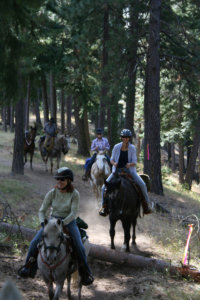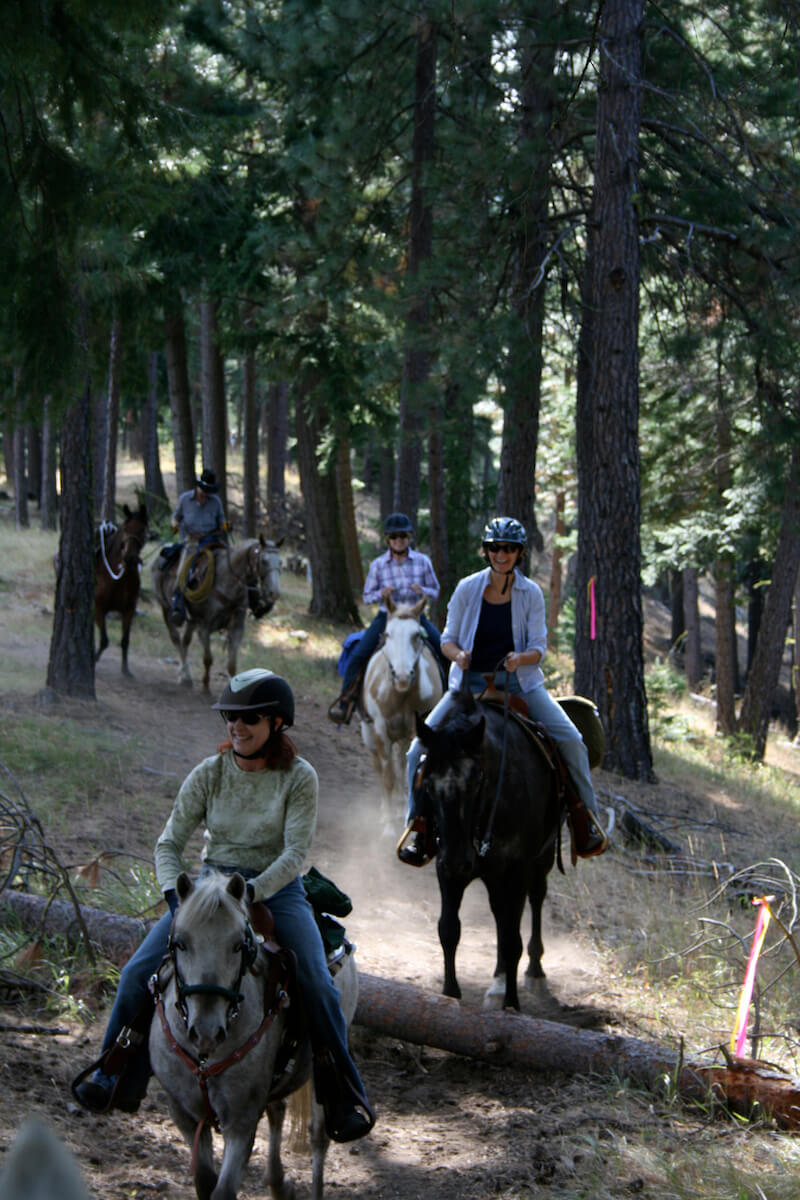Spare Your Horse the Unpleasant Side Effects of Being a “Weekend Warrior”
by Raye Lochert
Trail riding is the most popular equine activity among horse owners. However, unfortunate side effects of a weekend on the trail can include things like colic, tying up, and a variety of lameness issues all caused by a horse being out of shape. You wouldn’t want to go from watching TV all winter long to doing a 15 mile hike and neither does your horse. So how do you get your horse in shape for a 3-4 hour ride or longer? Try this 6-week conditioning program which can be customized according to how your horse is managed in the off season.
The amount of time you will need to spend conditioning your horse depends on how your horse is kept.
If he is kept in a stall or small paddock you may need to take more time in the conditioning process. If he is kept in a pasture of about 3 acres with a couple of friends he is in better shape than you think. In either case, a conditioning program is key. It does take time to condition your horse and most of us have other commitments to manage. Juggling everything is difficult and can be stressful. Do your best to prioritize.
To start the conditioning process I usually go to the round pen though lunging works, too. I start with three days of 20 minute workouts. If a horse has been in a stall I turn them loose in the pen for 5 minutes and let them move around on their own. This allows them to loosen up. If they are coming from a pasture I start the workout immediately. I ask for an easy trot controlling their speed with changes of direction. I trot them for at least 10 minutes. If they are very out of shape I will walk them from here, if not I will keep them trotting. It is important to watch for excessive sweating or heavy breathing. Don’t over-do it.
After the third day I work them from the saddle. I start with a 5 minute warm-up walk. This allows their muscles and back to warm up. From here I will work at the jog and trot for 10 minutes and then back to the walk. If I feel that they are doing well I will proceed to the jog/trot again for another 10 minutes. The entire workout for days 4-6 is 30 minutes.
Conditioning your horse physically for trail riding is only about a third of the game. Another component is mental conditioning. If your horse is young or inexperienced this is critical for their safety as well as yours. We have an obstacle course in one of our pastures with several man-made obstacles including a teeter totter, a hole in the ground, a trench, a bridge, tarp covered mattresses, and a trash pit (an area covered with crushed two liter plastic bottles). We also have some that are simulations of natural obstacles such as a pile of dirt and various log configurations.
In the second week I will lunge my horse through the obstacles for 30 minutes taking time to train him through anything that might cause anxiety. I will have him go over and through these obstacles at a walk and then a trot allowing speed to increase his emotions. After this lunging exercise I will ride him again using the 5 minute walk first then progressing to 20 minutes of alternating trot and canter work then cooling out with a 5 minute walk or longer if needed. This is done for 5 or 6 days of the week.

In the third week I’ll use the same routine as the second week but rather than lunging him through the obstacles I will ride. On alternating days I will take him for an easy 1 hour trail ride. On the trail rides I make sure he walks up the hills building his hindquarters and occasionally trot him on the flats. By now his mind is starting to be accustomed to the new things he may not have seen recently. I take any opportunity to go over logs, through water and work on spooky objects.
During the fourth week I try to ride on trail three days a week for about 90 minutes. I look for more challenging terrain while being careful not to over-do it. If you think your horse is stressed, then allow him to rest and/or get off and hand walk him. I get off and walk my horse down long steep hills regardless of his condition. This is just good horsemanship and shows concern for his joints and back.
In the fifth week we increase our rides to 2 hours 3 days a week while working at home for 30 minutes at a higher intensity twice a week. At home I will spend more time on the extended trot really getting him to lengthen his stride. This helps build his cardiovascular system as well as stretching his entire body.
During the last week of conditioning I will ride him on trail for 3 hours twice during the week with at least 3 days in between while continuing our intense home workouts 3 days a week. Once this week is over I feel comfortable to ride him on rides of up to 5 hours giving him lots of opportunities to rest. Rest stops may be as frequent as 5 minutes every mile while climbing steep hills. On long rides I take a lunch stop of at least 30 minutes. I also plan on tackling the hard terrain early in the ride rather than at the end of the ride.
Not everyone can make the time commitment that is needed to condition your horse for a ride so long. I use parks that are close by and do laps if the trails are short. We are fortunate enough to have the beach close by and can get a great work out in a short period of time. The plan I have outlined here is only a guide. You need to make adjustments for different horses and lifestyles. Once your horse is in shape you will find they maintain fitness better than humans do.
Published May 2012 Issue
Practical Horsemanship – that’s Raye. In an industry that’s exploding with information and trainers, Raye takes the confusion out of horse training. By taking a problem and breaking it down into smaller, doable steps, his solutions create successes for all horse people. No matter the discipline, the age of the horse or the level of experience or expertise of the rider, success is the end result.
There are many fantastic trainers in this industry. Unfortunately, a lot of what is being taught can’t safely be used by the average horse person. Raye wants to relay information in a way that makes sense and feels safe to everyone. If the horse handler finds it confusing or complicated, the horse doesn’t stand a chance.
In the vast sea of horsemanship clinicians, Raye is considered one of the most accessible teachers with an approachable style that truly sets him apart. His intense desire to help people achieve clear and consistent communication with their horses creates a much higher level of learning with his clients. No problem is too small and no question is silly.
In addition to clinics and lessons at Critter Creek Ranch in Santa Rosa, California, Raye travels all over the Western United States (including Hawaii and Alaska) conducting clinics, private lessons and demonstrations. His teaching is also available on DVDs and in special television programming. For more information on Raye Lochert and his schedule, visit Raye Lochert Horsemanship on Facebook.






